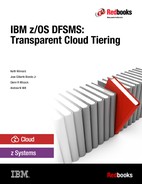

DFSMS cloud construct set up
This chapter describes how we used the Interactive Storage Management Facility (ISMF) ISPF application to define the cloud to DFSMS.
5.1 ISMF set up
To support the use of storage clouds, the new DFSMS cloud construct was added to ISMF panels. This new construct allows you to define the parameters that are necessary to connect to the clouds. The new Cloud option on ISMF menu is accessible only when you have access to the administrator mode on ISMF panels.
Figure 5-1 shows the new Cloud option that is available from main ISMF menu panel. Depending on your terminal configuration, it might be necessary to scroll down to view this new option.

Figure 5-1 New Cloud option on ISMF panel
Select the S option (Cloud) to open the Cloud Application Selection panel (see Figure 5-2). In this panel, you can list, display, define, or alter a cloud. As shown in Figure 5-2, we are defining (option 3) a cloud that is named IBMREDBOOKS.

Figure 5-2 Defining the IBMREDBOOKS cloud
The cloud definition process consists of two panels. The first panel is shown in Figure 5-3.

Figure 5-3 First cloud definition panel
The following fields are available for definition in the first cloud definition panel:
•SCDS Name: The name of the SCDS where the cloud construct is stored.
•Cloud Name: The cloud name that is used by DFSMShsm and DFSMSdss when communicating with the cloud. The same cloud name must be defined on the DS8000.
•Description: A brief description of the cloud you are defining. You can include some information about the service provider, service expiration date, or availability. Up to 120 characters can be used in description.
•Provider: Specifies the type of cloud provider. At the time of this writing, only SWIFT and SWIFT-KEYSTONE options are available.
•Identity: Specifies the credentials that are used when authenticating with the cloud. Up to 256 characters can be used (upper and lowercase, numbers, and “@”, “#”, “$”, “_”, “:” special characters).
Move to the second definition panel by using the DOWN command. The second panel is shown in Figure 5-4.

Figure 5-4 Second cloud definition panel
The following fields are available for definition in the second cloud definition panel:
•Endpoint: Identifies the Uniform Resource Identifier (URI) that is used when authenticating with the cloud. Up to 256 characters can be used (upper and lowercase, numbers, and several special characters).
•Port Number: Specifies the remote port number to which to connect. Possible values are 0 - 65535.
•SSL Version: Defines the lowest acceptable SSL version that is used when connecting to the cloud.
•SSL Key: Specifies the name of the keystore to be used. DFSMS supports the use of SAF key ring name or a PKCS #11 token.
After the cloud configuration is completed and saved, the SCDS that contains the cloud definition must be activated.
Activating the new configuration does not automatically connect z/OS to the cloud. Each application that is trying to access the cloud is required to provide the password to store and retrieve data.
The DS8880 must also be configured to access the cloud before the connection can be established.
To activate the SCDS, go to main ISMF menu and select option 8 Control Data Set, as shown in Figure 5-5.

Figure 5-5 Selecting the Control Data Set option
The CDS Application Selection panel is displayed, as shown in Figure 5-6. Select option 5. Activate the CDS to activate configuration.

Figure 5-6 Activate the CDS
Place a forward-slash in the Confirm Activate Request panel.
You can validate your Source Control Data Set (SCDS) by using option 4 Validate the SCDS before you make it the active CDS.
An alternative way of activating the CDS is by using the SETSMS SCDS(dsname) command.
..................Content has been hidden....................
You can't read the all page of ebook, please click here login for view all page.
